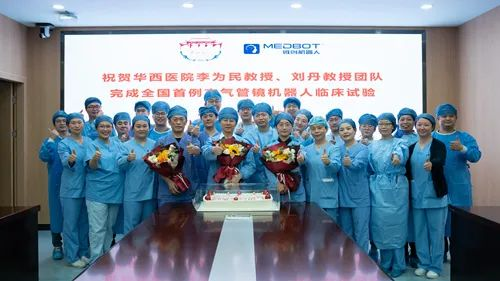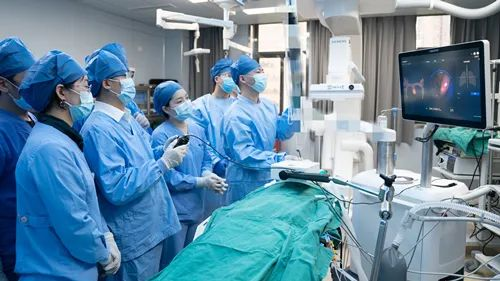The First Case in China! West China Hospital Completes Domestic Robotic-Assisted Trans-bronchial Lung Nodule Biopsy

Open the phone and scan
On March 30, 2022, Prof. Li Weimin, Prof. Liu Dan and their team at West China Hospital of Sichuan University successfully completed the first domestic robotic-assisted trans-bronchial lung nodule biopsy in China. The surgery is the first-in-man (FIM) clinical trial completed by a Chinese-developed trans-bronchial surgical robot, marking an important step forward for the trans-bronchial surgical robot in the field of lung disease diagnosis. The trans-bronchial surgical robot, also known as the robotic arm-controlled trans-bronchial navigation system, was jointly developed by West China Hospital of Sichuan University (“West China Hospital”), Shanghai Chest Hospital and Shanghai Chest Hospital affiliated to Shanghai Jiao Tong University (“Shanghai Chest Hospital”), and Shanghai MicroPort MedBot (Group) Co., Ltd. (“MicroPort® MedBot”), which fills the gap in the related field in China.

Lung cancer is the most common malignant tumor in China in terms of new cases and mortality rate. Early diagnosis and treatment is the key to improve the survival rate of lung cancer patients. With the popularization of chest CT examination, more and more lung nodules are detected, but the final diagnosis still needs to be confirmed by the gold standard test, i.e. pathological examination, so an innovative method of safe, accurate, whole-lung diagnosis and treatment is urgently needed in clinical practice.
In 2020, Prof. Li Weimin's team from West China Hospital and Prof. Sun Jiayuan's team from Shanghai Chest Hospital joined hands with MicroPort® MedBot to initiate a trans-bronchial surgical robot development project. Fully utilizing the advantages of medical-industrial integration, after three years of technological innovation and dedicated research and development, the domestic trans-bronchial surgical robot achieved completely independent development and design, which can help physicians safely reach the peripheral lung lesions for biopsy, breaking the long-term technology and product monopoly of overseas giants, reducing medical expenses, alleviating patients' economic burden, and promoting the rapid development and popularization of robotic surgery in China.
In this case, a 62-year-old female visited West China Hospital with “cough for 2+ months”. The chest CT scan showed a soft tissue shadow in the apicoposterior segment of the upper lobe of the left lung and no abnormality was found through conventional bronchoscopy. The nature of the patient's lung lesion was unknown. After detailed evaluation by Prof. Liu Dan's team and full communication with the patient and her family about the surgical plan, it was decided to perform trans-bronchial lung nodule biopsy with the assistance of MicroPort® Trans-bronchial Surgical Robot.

Before the operation, Prof. Li Weimin and Prof. Liu Dan's team imported the patient's lung CT images into MicroPort® Trans-bronchial Surgical Robot’s planning software, which generated a 3D high-precision model of the patient's lung anatomy. During the operation, Prof. Li Weimin, Prof. Liu Dan and Prof. Zhu Hui, under the guidance of the software, precisely controlled the bronchoscope to enter the bronchus in the posterior segment of the upper lobe of the left lung and reach the target position by using the specially designed operating handle, and successfully completed the biopsy under both direct endoscopic view and virtual image positioning, with simultaneous on-site cytological rapid evaluation to determine the success of the biopsy. The patient had no significant postoperative discomfort and was satisfied with the procedure.
The endoscopic lens and light source of the MicroPort® Trans-bronchial Surgical Robot do not need to occupy the working channel, which facilitates the surgeon to observe the whole puncture process in real time and achieve safer puncture. Its catheter is the slimmest in its class of robots with own lens and light source, so that the surgeon can examine small nodules deeper in the lung, promising true total lung coverage. In addition, the operation's electromagnetic sensors and intraoperative image alignment act like a GPS to track and locate the current bronchoscopic tip position in real time. The MicroPort® Trans-bronchial Surgical Robot is also equipped with intelligent cutting-edge technologies to assist surgeons in preoperative planning, respiratory compensation, and real-time intraoperative precision positioning and navigation.
Prof. Li Weimin commented after the surgery, "It has been a major challenge to improve the diagnostic rate of peripheral lung cancer using conventional bronchoscopy in the industry. The MicroPort® Trans-bronchial Surgical Robot is able to access deeper lung tissue and accurately biopsy micronodules, allowing for the diagnosis of lung cancer at an earlier stage. As a leading national base for medical scientific research and technological innovation in China, West China Hospital has been committed to promoting domestic medical technology innovations through collaboration between doctors and engineers. Early screening and precise treatment of lung cancer can considerably increase patients' chances of survival and enhance their quality of life. We hope that through the collaboration with MicroPort® MedBot, we can achieve early and precise diagnosis and treatment of lung cancer and improve the survival rate of patients with lung cancer. ”


